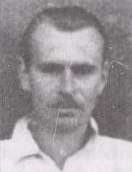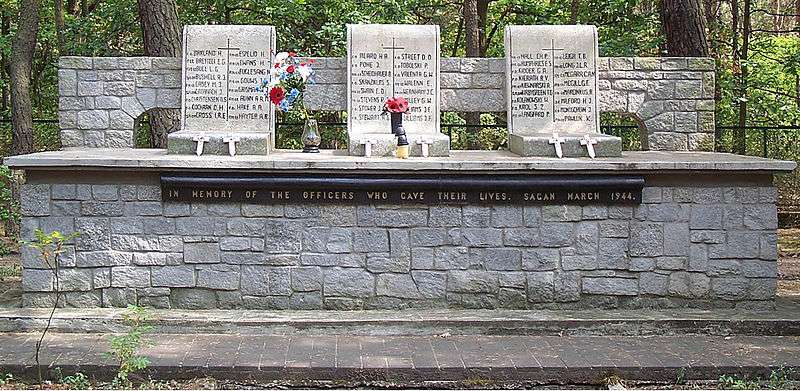Charles Piers Egerton Hall
Charles Piers Egerton Hall, nicknamed Chaz Hall[1] (25 July 1918[2] – 30 March 1944) was a British pilot who was taken prisoner during the Second World War. He was part of the 'Great Escape' from Stalag Luft III in March 1944, but was captured and subsequently shot by the Gestapo.
Charles Piers Egerton Hall | |
|---|---|
 Charles Piers Egerton Hall | |
| Birth name | Charles Piers Egerton Hall |
| Born | 25 July 1918 Kings Norton, Worcestershire, England |
| Died | 30 March 1944 (aged 25) Liegnitz |
| Allegiance | |
| Service/ | |
| Years of service | 1941–1944 |
| Rank | Flight Lieutenant |
| Service number | 50896 |
| Unit | 1st Photographic Reconnaissance Unit |
| Battles/wars | World War II |
| Awards | |
War service
Hall was born in Kings Norton; He enlisted in the Royal Air Force pre-war as a regular service airman with the service number 550173, before the war he had been a photographer in Halton.[3] Hall was a leading aircraftman at the time he was commissioned as pilot officer on 17 April 1941 [4] and promoted flying officer on 17 April 1942.[5] During World War II he served as a flight lieutenant in the Royal Air Force Volunteer Reserve, including serving for a time aboard HMS Ark Royal.[3] He later became a pilot for the 1st Photographic Reconnaissance Unit (PRU) flying out of RAF Benson South Oxfordshire,[6] England. Hall was promoted flight lieutenant on 17 April 1943.[7]
Prisoner of war
Hall was flying a 1 PRU Spitfire PR Mk.IV (AA804)[8] on 28 December 1941[3] when the aircraft came down over Bergen op Zoom, the Netherlands. He had been on high level reconnaissance mission to Düsseldorf when he was either shot down or suffered engine failure (accounts vary).[6] It was the aircraft's first operational flight[6] and Hall's third operational flight.[3][6] He became a prisoner of war and was sent to Stalag Luft III[3] in Germany in the province of Lower Silesia near the town of Sagan (now Żagań in Poland).
'Great Escape'
He was one of the 76 men who escaped the prison camp on the night of 24–25 March 1944, in the escape now famous as "the Great Escape".[3] He was recaptured near Sagan.[2] He became one of the 50 executed and murdered by the Gestapo[2] on the personal orders of Adolf Hitler on 30 March 1944 and then cremated at Liegnitz, now part of the Poznan Old Garrison Cemetery.[2] Before his execution he had written on his cell wall "We who are about to die salute you".[3]

Awards
His conspicuous bravery was recognized by a mention in Despatches as none of the other relevant decorations then available could be awarded posthumously.[9]
References
- Notes
- The Porter Family History The Fifty
- Details of the "Great Escape" Archived 24 May 2009 at the Wayback Machine compiled by USAF 392nd Bomber Group Association
- Vance, Jonathan F (2000). A Gallant Company: The Men of the Great Escape. California: Pacifica Military History; illustrated edition (Mar 2001). p. 54. ISBN 978-0-935-55347-5.
- "No. 35158". The London Gazette. 9 May 1941. pp. 2674–2675.
- "No. 35628". The London Gazette. 10 July 1942. pp. 3047–3048.
- Spitfire AA804 - why FTR RafCommands Forums
- "No. 36051". The London Gazette (Supplement). 8 June 1943. pp. 2680–2681.
- AA804 ASN Aviation Safety
- "No. 36544". The London Gazette (Supplement). 2 June 1944. pp. 2619–2620.
- Bibliography
- William Ash; Brendan Foley (2005). Under the Wire: The Wartime Memoir of a Spitfire Pilot, Legendary Escape Artist and 'cooler King'. Bantam. ISBN 978-0-593-05408-6.
- Paul Brickhill (2004). The Great Escape. W.W. Norton & Company. ISBN 978-0-393-32579-9.
- Alan Burgess (1990). The Longest Tunnel: The True Story of World War II's Great Escape. Naval Institute Press. ISBN 978-1-59114-097-9.
- Albert P. Clark (2005). 33 Months as a POW in Stalag Luft III: A World War II Airman Tells His Story. Fulcrum Pub. ISBN 978-1-55591-536-0.
- Memories of an Australian prisoner of Stalag Luft III - Sergeant Alf Miners; the Wartime Memories Project
- Arthur A. Durand (1 January 1989). Stalag Luft III: The Secret Story. Patrick Stephens Limited. ISBN 978-1-85260-248-2.
External links
- Project Lessons from the Great Escape (Stalag Luft III), by Mark Kozak-Holland. The prisoners formally structured their work as a project. This book analyses their efforts using modern project management methods.